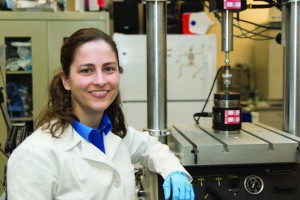 Jacque Cole ’01, mechanical engineering
Jacque Cole ’01, mechanical engineering
Assistant Professor
Joint Department of Biomedical Engineering
University of North Carolina at Chapel Hill and North Carolina State University
Raleigh, N.C.
Early years . . . My dad is a mechanical engineer, so I was exposed to engineering at a very young age. I think I was the only first grader who had a calculator watch and used a mechanical pencil . . . so I guess you can say that I’ve always wanted to be an engineer.
Typical day . . . I am the director of the Orthopaedic Mechanobiology Lab, and the goal of our research is to improve current strategies for preventing and treating bone loss from aging, disease and injury. We focus on the mechanical, metabolic and vascular factors that improve therapies for bone regeneration . . . I also teach a senior/graduate biomechanics class. Right now, my days are filled with research – training students to do CT image data analysis, mechanical testing and histology, as well as developing and writing several research grant proposals.
Current projects . . . We are measuring structural and cellular changes in bone tissue following a stroke, and determining the effect of exercise type, frequency and duration on stroke recovery . . . stroke is the leading cause of permanent disability in developed countries, and current treatments are not very effective for most patients. Our study will hopefully provide insight into the best exercise therapy to achieve optimal recovery.
Engineering challenge . . . Bone is very complex, from both a material and structural viewpoint . . . it’s a composite material that has both anisotropic and viscoelastic properties. Its structure varies widely from the dense cortical bone in the shaft of long bones to the porous cancellous bone in the ends of long bones and in the vertebrae. The most challenging part is that bone is a living tissue that is constantly changing and remodeling. Figuring out robust therapeutic strategies often feels a lot like hitting a moving target in gale force winds.
My Auburn Engineering . . . The most valuable part of my Auburn experience was working on the Baja and Formula SAE teams for four years . . . it trained me to appreciate the intricacies of complex systems and to balance engineering knowledge with real-world intuition. Perhaps even more importantly, I learned to engage productively in teams and communicate ideas and solutions effectively.
Turning point . . . I had a few of these . . . when I was a sophomore, Carol Chancey (’98 M.S., mechanical engineering) and Nicole Faulk (’99 M.S., mechanical engineering) planted the seed that I should go to graduate school. I followed their advice, but I always intended to get a job in industry afterwards. During my third year at Cornell, I was a teaching assistant and realized how much I enjoy working with and mentoring students . . . that ultimately changed my mind about staying in academia.
Sense of pride . . . I love that I’m working on ways to improve skeletal health, which may one day impact clinical care and prevent bone fractures. The best part of my job, though, is mentoring and guiding the career paths of engineering students, which amplifies my contributions to society.
Geek moment . . . When I had my prenatal ultrasound last fall, I was more interested in my son’s skeletal development and femoral length measurements than in the usual head circumference and weight estimates. I think the technician got a good chuckle out of my “Look at his bone structure!” exclamation.